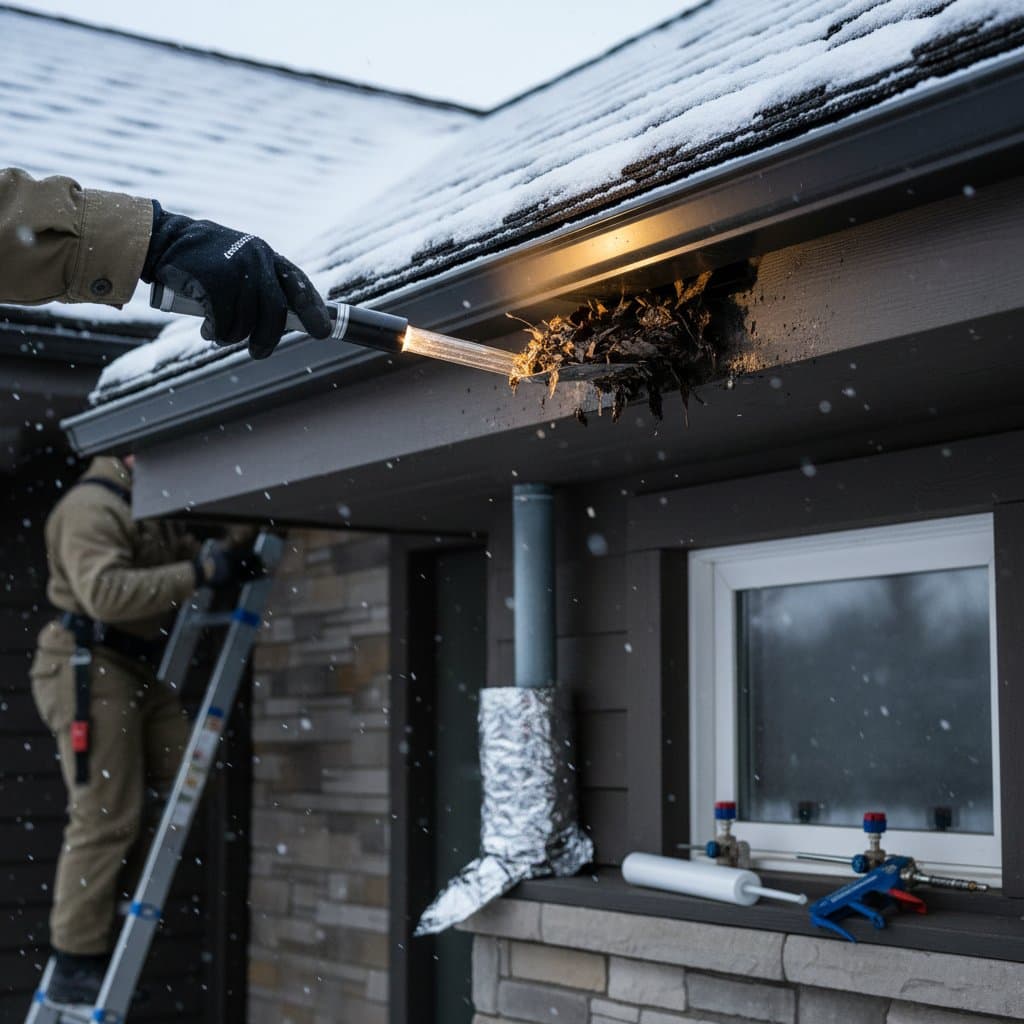Subtle Sounds Warning of Costly Winter Home Damage
When winter arrives with its first icy winds, subtle sounds often reveal vulnerabilities in your home. A faint whistle from a window frame suggests drafts that could lead to heat loss and structural strain. A persistent drip from the gutters points to clogs that invite ice buildup and roof damage. The groan of a branch scraping the roof warns of potential breaches during storms. These small indicators, if addressed promptly, prevent extensive and expensive repairs.
Preparation transforms these warnings into opportunities for resilience. This guide outlines essential steps to inspect and fortify your home, maintain energy efficiency, and safeguard key systems against cold weather assaults.
Step 1: Inspect and Fortify the Roof
Roofs endure the most severe winter elements, including snow loads, freeze-thaw cycles, and high winds. Begin with a ground-level visual check using binoculars to spot curling or missing shingles, granule loss, sagging sections, or deteriorated flashing. These issues amplify under snow weight, leading to leaks and collapses.
If ladder use feels safe, remove loose debris from the roof edges. For thorough assessment, engage a licensed roofing professional; their inspection fees range from 150 to 300 dollars. Early repairs, such as replacing damaged shingles, avert leaks that could cost thousands.
Apply snow guards or heating cables in snowy regions to mitigate ice dams. These installations distribute weight evenly and prevent gutter overflows.
Step 2: Clear Gutters and Secure Windows
Clogged gutters produce dripping sounds that signal water backup, fostering ice dams and foundation erosion. Schedule a pre-winter cleaning to remove leaves and debris; downspouts should direct water at least five feet from the home base. Install gutter guards if recurring clogs persist, reducing future maintenance.
Windows whistling in the wind indicate gaps that allow cold infiltration and moisture damage. Inspect seals and frames for cracks, then apply weatherstripping or caulk to seal them. For older windows, consider storm panels or double-glazing inserts to enhance insulation without full replacement.
Professional gutter service costs 100 to 200 dollars, while window sealing kits run under 50 dollars. These measures preserve interior warmth and prevent frame warping.
Step 3: Protect Plumbing from Freezing
Burst pipes rank among the most destructive winter events, as freezing water expands and ruptures lines. Identify exposed pipes in basements, attics, and exterior walls, then insulate them with foam sleeves or electrical heat tape. These solutions cost less than 50 dollars per section and install in hours.
For outdoor faucets, close interior shutoff valves, drain lines, and fit insulating covers. During extreme cold, open cabinet doors beneath sinks to circulate room heat, and maintain indoor temperatures above 55 degrees Fahrenheit when absent.
A single burst pipe repair exceeds 5,000 dollars in water damage; prevention demands minimal investment but yields substantial protection.
Step 4: Seal Drafts and Boost Insulation
Drafts create whistling noises and drive up heating costs by 20 percent or more. Conduct a home energy audit by feeling for air leaks around doors, outlets, and baseboards on a windy day. Seal gaps with expandable foam for larger holes or draft stoppers for doors.
Attic insulation prevents heat escape; add blown-in cellulose or fiberglass if depth falls below 12 inches in cold climates. Basement walls benefit from rigid foam boards to block ground moisture.
These upgrades, often DIY-friendly, cost 200 to 500 dollars and qualify for energy rebates in many areas. They stabilize temperatures and reduce utility bills year-round.
Step 5: Evaluate Exterior Drainage and Landscaping
Poor drainage amplifies storm impacts, with pooling water freezing into expansive ice near foundations. Ensure ground slopes at least six inches over ten feet away from the house; regrade soil if necessary using a shovel and tamper.
Clear French drains, sump pumps, and yard inlets of debris, then test pumps by simulating water inflow. In flood zones, add battery backups to maintain function during outages.
Trim overhanging branches to eliminate scraping sounds and reduce snow-load risks; arborist fees range from 300 to 800 dollars based on scope. Proper landscaping diverts moisture and safeguards structural integrity.
Step 6: Inspect Windows and Doors for Seals
Beyond initial checks, verify door thresholds and window locks for tightness, as loose fittings allow wind-driven rain to infiltrate. Replace worn sweeps on doors and ensure screens fit snugly to block pests during milder spells.
For sliding doors, lubricate tracks with silicone spray to prevent sticking in cold. If condensation forms inside window panes, it signals failed seals requiring professional argon gas refill or replacement.
These targeted fixes, costing 50 to 150 dollars, enhance security and comfort while minimizing energy loss.
Step 7: Service Heating and Power Systems
Heating systems demand annual attention to operate efficiently amid prolonged cold. Schedule a technician for furnace or boiler tune-ups, including filter changes and thermostat calibration; services cost 100 to 200 dollars.
Clean chimneys for fireplaces to remove creosote, with inspections at 150 to 350 dollars. Test generators for backup power and place carbon monoxide alarms near bedrooms.
Reliable systems avoid breakdowns that spike repair bills and ensure safety during outages.
Build a Seasonal Maintenance Routine
Approach winter readiness as a systematic process, prioritizing high-risk areas like roofing and plumbing first. DIY enthusiasts can handle inspections and sealing over weekends, investing under 300 dollars total. Delegate structural tasks to certified experts for code compliance and warranties.
Maintain a checklist tailored to your property, revisiting it each fall. This practice evolves into a straightforward tradition that fortifies your home against seasonal threats.
Secure Future Savings and Comfort
Investing in winter preparation yields enduring advantages, from slashed energy costs to prolonged component lifespans. Homes with solid defenses experience fewer emergencies, lower insurance premiums, and greater market value. Proactive care not only averts immediate damage but cultivates a safer, more efficient living environment for years ahead.
